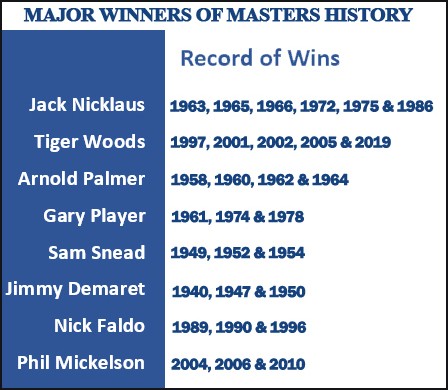December 2020
Golf Teaching Pro® Coming This Month
USGTF Inside News
USGTF Competition To Resume In February With SE Championship
Industry News – Masters Recap
“PRO” File – Dustin Johnson
EDITORIAL – Masters History Most Special Among the Four Majors
The Open (formerly called The Open Championship, and prior to that formerly called the British Open) is the oldest of the four majors. The U.S. Open has a storied history almost as long, dating back to 1895. Next up is the PGA Championship, first played in 1916. The Master is the new kid on the block with its debut in 1934, but it can be fairly argued that the history of the Masters is the most special among the four. For one, it is played at the same location every year at perhaps the most famous golf course in the world, with apologies to the Old Course at St. Andrews. Even the most ardent of golf fans will be hard-pressed to describe all the holes on the final nine at the Old Course, but no one has any such trouble with the final nine at Augusta National. Yes, the course is that memorable and special.
The history of the tournament itself is among the most storied. Although none of us were around back then, Gene Sarazen’s double-eagle on #15 during the final round in 1935 is legendary. The 1975 edition featured a battle royal between Jack Nicklaus, Tom Weiskopf and Johnny Miller, and is still talked about to this day.
Nicklaus’ amazing 1986 victory was even better, perhaps matched only by Tiger Woods’ comeback win in 2019. Many observers and so-called “experts” thought Woods would never win another Masters title, as he was too old and could not keep up with the younger generation (as was thought about Nicklaus in ’86). He proved the doubters wrong with a textbook example of course management, attacking at the right time and playing conservatively at others. The roars on #18 after he putted out were said to be the loudest ever heard at Augusta, eclipsing even those of Nicklaus’ 1986 win.
Then there are the details people remember, both successful and not: Curtis Strange dunking two balls on #13 and #15 in 1980, costing him the title; Chip Beck laying up on #13 in 1994 while battling Bernhard Langer; Phil Mickelson pulling off the shot of a lifetime off the pine straw on #13 in 2010; Bubba Watson’s hooked wedge in 2012 during his playoff with Louis Oosthuizen, and many others, too numerous to mention here.
Nicklaus’ six victories leads the way, followed by Woods’ five. Arnold Palmer comes in next with four green jackets. Gary Player owns three of them, as does Sir Nick Faldo, Mickelson, Sam Snead and Jimmy Demaret. No matter which aspect of Masters history we choose to look at, it’s hard to say it’s not the richest in our sport.
By Mark Harman, USGTF Director of Education







